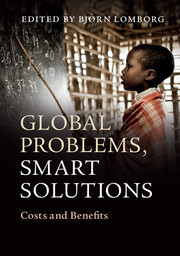Book contents
- Frontmatter
- Contents
- List of Figures
- List of Tables
- List of Contributors
- Acknowledgments
- Selected abbreviations and acronyms
- Introduction
- Part I The Solutions
- 1 Armed Conflicts
- 2 Ecosystems and Biodiversity
- 3 Chronic Disease
- 4 Climate Change
- 5 Education
- 6 Hunger and Malnutrition
- 7 Infectious Disease, Injury, and Reproductive Health
- 8 Natural Disasters
- 9 Population growth
- 10 Water and Sanitation
- 11 Corruption and Policy Reform
- 12 Trade Barriers and Subsidies
- Part II Ranking the Opportunities
- Conclusion: Making Your Own Prioritization
- Index
- References
10 - Water and Sanitation
Published online by Cambridge University Press: 05 June 2014
- Frontmatter
- Contents
- List of Figures
- List of Tables
- List of Contributors
- Acknowledgments
- Selected abbreviations and acronyms
- Introduction
- Part I The Solutions
- 1 Armed Conflicts
- 2 Ecosystems and Biodiversity
- 3 Chronic Disease
- 4 Climate Change
- 5 Education
- 6 Hunger and Malnutrition
- 7 Infectious Disease, Injury, and Reproductive Health
- 8 Natural Disasters
- 9 Population growth
- 10 Water and Sanitation
- 11 Corruption and Policy Reform
- 12 Trade Barriers and Subsidies
- Part II Ranking the Opportunities
- Conclusion: Making Your Own Prioritization
- Index
- References
Summary
The challenge
The world has met the MDG on water five years early, according to the most recent Joint Monitoring Program update, released in March 2012, but will miss its goal on basic sanitation by almost 1 billion people (WHO/UNICEF, 2012). An astonishing one-third of the world population, 2.5 billion people, does not have access to basic sanitation and over 1 billion people defecate out in the open. In light of the evidence that the world community is making progress in the water sector, and because sanitation is typically the neglected half of the water and sanitation challenge, including in the 2008 Copenhagen Consensus Challenge Paper on water and sanitation (Whittington et al., 2008) this chapter redresses that imbalance and focuses primarily on sanitation and the question of whether and how it would be cost-effective to dramatically change levels of investment to solve this problem.
The benefits of sanitation as a public health solution seem self-evident. Quotations like this from a Lancet editorial are easy to find:
It is already well known that improved sanitation could prevent 1·5 million deaths from diarrheal illnesses a year, enhances dignity, privacy, and safety, especially for women and girls, benefits the economy – every dollar spent on sanitation generates economic benefits worth around nine more – and is better for the environment. (Lancet, 2008)
In the United States, large public sector investments to provide clean water and sewerage were jointly responsible for most of the rapid decline in the child mortality rate in the early twentieth century (Cutler and Miller, 2005), and more recently for substantial health improvements on Native American Indian reservations (Watson, 2006).
- Type
- Chapter
- Information
- Global Problems, Smart SolutionsCosts and Benefits, pp. 597 - 631Publisher: Cambridge University PressPrint publication year: 2013
References
- 2
- Cited by



